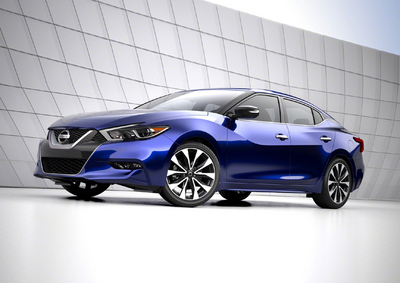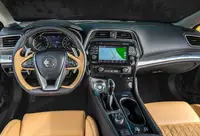2016 Nissan Maxima SR Review +VIDEO
 2016 Nissan Maxima |
The 2016 Nissan Maxima combines distinctive style with good performance and fuel economy
DRIVING DOWN THE ROAD WITH CAREY RUSS
• SEE ALSO: Nissan Research and Buyers Guide
Nissan's Maxima has always been different from other Japanese-marque midsize sedans. It debuted in the 1980s with the engine from the original 240Z -- in a slightly lower state of tune -- in a rear-wheel drive chassis with a fully-independent suspension when competitors were front-wheel drive. A 1985 chassis change to front-wheel drive dulled it not at all, as careful tuning and the engine from the then-current 300ZX emphasized its sporty character. The peak was between 1989 and 1995, when Nissan called its Maxima "the 4-Door Sports Car", aka 4DSC. It was a fine, and affordable, sports sedan, as much a rarity then as now from a non-European automaker.
 2016 Nissan Maxima |
Then the Nissan world changed. The Maxima got softer and more luxury-oriented and the 4DSC was consigned to history. As, nearly, was Nissan itself…
Which was saved in 1999 by an alliance with French-based manufacturer Renault. If that was surprising, so was the result - a resurgent Nissan. Style and performance were soon back, first in the form of the 350Z and then most emphatically with the GTR. The Maxima was renewed as 4DSC in 2009, and that generation lasted until model year 2015.
Although the 2016 Maxima looks radically different, it's still based on the latest version of Nissan's "D" platform and uses the newest iteration of the 3.5-liter VQ35DE V6 engine. But there has been considerable development -- the unibody structure has been re-engineered for greater rigidity with about 80 pounds less weight, while the engine boasts 61 percent new parts and more power --- now 300 horsepower and 261 lb-ft of torque -- on less fuel. A revised "Xtronic" computer-managed continuously-variable transmission (CVT) with an extremely wide ratio spread gets some of the credit there, too. More power, less weight -- the best recipe for efficiency with (driving) entertainment.
The 2016 Maxima model lineup has expanded. All share the 3.5 V6 / CVT / front-wheel drive drivetrain. Entry S and value-packaged SV are familiar from before, and the more luxury-oriented SL has been available in past generations. But to emphasize the new Maxima's sport-meets-luxury character more, there are two new upper levels, the sport-oriented SR and luxury Platinum. Platinum gets higher-grade leather inside, woodgrain trim, and additional luxury and convenience features. SR gets suede-like Alcantara® seat and steering wheel trim, a firmer suspension tuning with electronic ride control, and other performance-oriented enhancements. One option not available in an SR is a sunroof. Why? A hole in the roof decreases rigidity and the glass sunroof and its mechanism add weight.
The best of earlier Maximas that I've driven over the years have been pleasantly sport-touring in character. Not "sports sedan" in the most narrow definition, and all the better for everyday use in the real world by more people than that. The new one builds on that, especially in SR trim like this week's test car. In town, on the highway, and on the scenic route it's quiet and composed and never harsh or demanding. Yes, it's front-wheel drive and has a CVT, characteristics that can work against "real" sports sedan characterization. Which was never really the point of the "4-Door Sports Car". Think "pleasing to drive, especially at an enthusiastic but not racing pace and comfortably quiet and relaxing" and you'll understand. And the wide-range CVT means that not only is the newest Maxima quick and pleasant, it also sips unleaded premium to the tune of low- to mid-20s around town and on back roads and high 20s on the highway despite having 300 horsepower.
APPEARANCE: You want distinctive? You got it! No one will confuse the newest Maxima with any other car. I've seen other colors, but the Deep Blue Pearl featured for the SR -- and the color of my test car -- showcases its flowing lines best. It's the second Nissan to showcase the company's newest design language, introduced on the newest Murano crossover last year. It shares concepts -- the "V-Motion" front styling, "floating" roof, an optical trick done with gloss black window trim, and "boomerang" head- and tail-lights -- but in a sedan form that, in common with many today, is more "four-door coupe" than three-box sedan. The windshield is at a low angle, and the roof flows in an arch to behind the rear wheels. Sharp character lines on the sides emphasize the fenders, and chrome trim at the bottom of the side windows sweeps upwards behind the rear doors to give a more muscular appearance. In dark colors, the styling is cohesive; in lighter colors, less so. But in any color, it's never going to be dull or boring.
COMFORT: The upper trim levels of the Maxima lineup compete with entry-luxury sedans more than the common mass-market ones. And so the Maxima's interior is fully competitive, with design, materials, and features equal to or better than what is found in cars from luxury brands. Stitched soft-touch materials surround passengers. Seats in the SR are leather, with diamond-stitched Alcantara® inserts. Front buckets are power-adjustable of course, and both heated and cooled here. The manually-adjustable (tilt and reach) steering wheel has a heated, leather and alcantara-covered rim and controls for audio, information, phone, and cruise systems. Bright electroluminescent instruments are readily visible and windshield glare is minimal. NissanConnect telematics with navigation is standard in all models, and is accessed through the touchscreen at the top of the center stack. Auxiliary controls are found on the steering wheel and console. The now-expected overload of information is available, even including engine output. Best to let the front passenger watch that… Audio choices are all that are expected, AM, FM, and Sirius/XM radio, CD, external players via jack and USB, and Bluetooth streaming. Rear passengers are treated to plenty of space and conveniences including floor heat and console HVAC vents. There is a space-saver spare tire under the floor of the large trunk, and a 6/40 folding rear seatback for times when more cargo space is necessary.
SAFETY: The Maxima's unibody structure features Nissan's "Zone Body Construction", with a strong central structure and front and rear crumple zones. The "Advanced Air Bag System" includes seat belt sensors, the occupant classification system, and dual-stage front, front seat-mounted side, and roof-mounted side impact airbags. A tire-pressure monitoring system and the Vehicle Dynamic Control stability control system and traction control are all standard in all models. At SL and above, blind-spot monitoring with cross-traffic alert, intelligent cruise control, predictive forward collision warning, and forward emergency braking are also standard.
RIDE AND HANDLING: Less is more? Revisions to the Maxima's unibody structure resulted in greater rigidity and less weight. Greater use of high-strength steel is one reason. Suspension is fully independent, by struts in front and a multi-link double wishbone system in the rear. Befitting its sporty status, the SR gets stiffer springs and dampers, more a sport-touring tuning than pure sports and all the better for everyday use for that. It also gets a Performance Chassis Damper similar to the one on the 370Z NISMO to dampen high-frequency vibrations from the stiffer tuning. Steering has a speed-sensitive assist similar to that found in the Z, and is light at low speeds for easy maneuverability and appropriately firmer at speed for control and stability. The newest Maxima is quiet and composed on the road. With 300 horsepower on tap, torque steer would be expected. It does show, but only rarely and then only in extreme circumstances such as hard throttle from low speeds up hill.
PERFORMANCE: Nissan's engineers keep finding more power in the VQ35DE V6. With many of its internal parts new, it makes another ten horsepower maximum, now an even 300 (at 6400 rpm) with no decrease in torque -- still 261 lb-ft at 4400 rpm. Sodium-filled exhaust valves help the engine cope with high temperatures from lean mixtures that improve emissions and fuel economy. Also helping there is the newest version of Nissan's "Xtronic" computer-controlled CVT. It has a wide ratio spread and a high "top gear" ratio for both good acceleration and efficient highway cruising. It has regular and sport modes; sport mode quickens throttle response and re-maps shifting to favor acceleration and power over economy. It also reduces steering assist and increases the Active Sound Enhancement system for more engine music in the cabin. Manual shifting is also possible, if rarely necessary. As before, the Maxima's shift paddles don't rotate with the steering wheel so a proper shuffling of hands for maximum control means the shifters are always available. The difference between normal and sport mode is not great, with sport a bit better on an uncrowded back road and normal just fine everywhere else. 0-6 time is around six seconds, so short onramps and other situations where quick acceleration is a safety factor are non-issues. And despite the potential of 300 horsepower, I averaged 25 mpg for my week.
CONCLUSIONS: The 2016 Nissan Maxima combines distinctive style with good performance and fuel economy.
SPECIFICATIONS
2016 Nissan Maxima SR
Base Price $ 37,670
Price As Tested $ 38,750
Engine Type DOHC 24-valve aluminum alloy V6
Engine Size 3.5 liters / 214 cu. in.
Horsepower 300 @ 6400 rpm
Torque (lb-ft) 261 @ 4400 rpm
Transmission CVT
Wheelbase / Length 109.3 in. / 192.8 in.
Curb Weight 3564 lbs.
Pounds Per Horsepower 11.9
Fuel Capacity 18.0 gal.
Fuel Requirement 91 octane unleaded premium gasoline
Tires 245/40R19 94W m+s Goodyear Eagle F1 Assymetric
Brakes, front/rear vented disc all around, ABS, EBD, BA standard
Suspension, front/rear independent strut / independent multilink
Drivetrain transverse front engine, front-wheel drive
PERFORMANCE
EPA Fuel Economy - miles per gallon city / highway / observed 22 / 30 / 25
0 to 60 mph 5.9 sec
OPTIONS AND CHARGES
Sport floor and trunk mats and trunk net $ 255
Destination charge $ 825
The Most Nissan Vehicle Research Information Anywhere!


